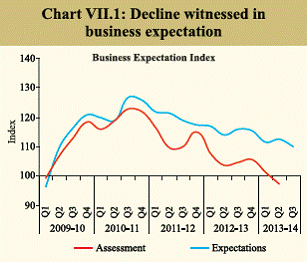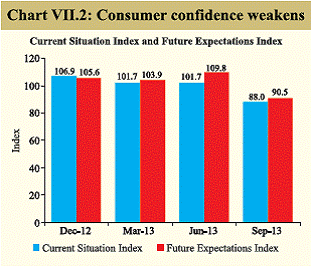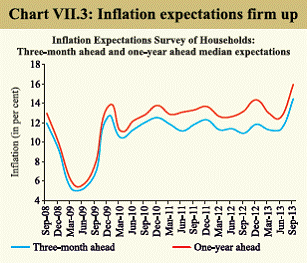 IST,
IST,
VII. Macroeconomic Outlook
After two years of growth deceleration, the slowdown extended into 2013-14 amid domestic structural constraints, dampened global cyclical conditions and dented business confidence. Growth forecasts by external agencies and professional forecasters have been revised downwards. Inflation expectations and inflation have begun to edge up again as the second round impact of already high food and fuel prices has come into play. In these circumstances, the revival in growth will require complementary monetary, fiscal and regulatory policies. At this juncture, it is important to maintain macroeconomic stability so as to allow further impetus to growth to come from productivity enhancing structural reforms, addressing supply constraints and ensuring quick project implementation. Modest improvement in growth possible in H2 of 2013-14 VII.1 Indian economy has continued to slowdown for the third year in succession. In part, the slowdown is the result of global cyclical conditions that have resulted in most emerging markets and developing economies (EMDEs) slowing down. However, the slowdown has been exacerbated by domestic factors, a large part of which can be addressed through concerted policy actions and their implementation. Small but sustained policy steps can deliver growth back to the economy. Further productivity enhancements and containment of high wage inflation are possible by making labour markets more flexible and by improving human capital formation given the abundant labour supplies. VII.2 To recoup India’s potential growth, first and foremost it will be necessary to secure macroeconomic stability as failure to do so can result in a lasting growth collapse. High persistent inflation is inimical to growth. Inflation based on CPI-IW has averaged 9.5 per cent for the last six years and the headline WPI inflation has averaged 8.6 per cent during the last three years. Such high inflation eroded real consumption, lowered savings, caused financial disintermediation, widened the current account gap and placed additional pressures for subsidised safety nets for the vulnerable population. Against this backdrop, monetary policy will have to tread a carefully charted course to support reasonable real interest rates and avert financial repression. VII.3 Growth has slackened to a 17-quarter low of 4.4 per cent during Q1 of 2013-14. On current reckoning, growth in 2013-14 is likely to stay at about the level of last year. After a slower H1, a modest recovery is likely in H2 of 2013-14. This is expected to come from a rebound in agricultural growth backed by a better than normal south-west monsoon and a pick-up in exports. VII.4 While the current account deficit (CAD) risks have receded somewhat, what is important for now is that monetary and fiscal policies retain focus on maintaining macroeconomic stability. Meanwhile, structural policy measures and ground-level actions could work to boost growth over the medium-term. Inflation may remain range-bound in H2 of 2013-14 but disinflation process is incomplete VII.5 The WPI inflation trajectory changed in Q2 of 2013-14 with a turnaround since July 2013. On the current assessment, WPI inflation may remain range bound around the current level during H2 of 2013-14. This indicates persistence of inflation at levels distinctly above what was indicated by the Reserve Bank earlier in the year. Even though non-food manufactured products inflation remains low at present due to dampened demand-side factors and lower commodity prices, persistence of inflation in H2 can arise as high food and fuel inflation exert some cost push pressures on manufactured product prices and as high wage inflation feeds through to general level of prices. VII.6 An important element in shaping the inflation outcome during 2013-14 will be inflation in primary food articles that rose to 18.4 per cent in September 2013 mainly due to a significant escalation in vegetable prices during H1 of 2013-14. As a base case, food inflation should soften during H2 on the back of possible bumper foodgrains and oilseeds output. However, the degree of fall in food inflation will be conditioned by food management, the extent of ratchet effect in vegetable prices and supply responses in protein-rich products. VII.7 A fall in food inflation is a prerequisite to bring CPI inflation to a more reasonable level in line with the trends in emerging markets. However, pending sufficient supply responses, it is important that monetary policy keeps a tight leash to prevent relative price shocks in the current year from getting generalised. While the negative output gap is likely to have a disinflationary impact, supply constraints and the absence of a sufficiently competitive industrial structure can moderate its effect. Persistence of CPI inflation could also come from the second round effects of exchange rate pass-through and administered price revisions that can impact prices across a wide range through transportation costs. Also, inflation expectations and demand factors can keep price pressures elevated in services segments like education and health. Surveys show business confidence continues to weaken VII.8 The confidence channel has played an important role in the current growth slowdown. However, business confidence shows little improvement and continues to remain weak. This is indicated by moderation on a y-o-y and q-o-q basis in key indices of various surveys (Table VII.1). According to FICCI, weak demand, cost and availability of credit continue to be concerns. While the Dun and Bradstreet Business Confidence Index showed moderate improvement over the previous quarter, it remained below the level registered in Q4 of 2012-13. VII.9 The seasonally adjusted HSBC Markit Purchasing Managers’ Index (PMI) for both manufacturing and services contracted in September 2013. The index for output prices decelerated for both manufacturing and services while input prices for manufacturing accelerated during the month. Industrial Outlook Survey reflects weak business sentiment, moderation expected ahead VII.10 The Reserve Bank’s 63rd round of the Industrial Outlook Survey (/en/web/rbi/-/publications/industrial-outlook-survey-q2-2013-14-round-63-15421) conducted during August-September 2013, showed that in terms of assessment, the Business Expectation Index (BEI) dropped significantly for Q2 of 2013-14, falling below the threshold level of 100, separating contraction from expansion, and touching the lowest point since Q1 of 2009-10. For Q3 of 2013-14, expectations remained well above the threshold level (Chart VII.1).
VII.11 Analysis of the net responses among various components of demand conditions shows that while the sentiments on production remained broadly unchanged, the sentiments on order books, capacity utilisation, exports and imports dropped substantially for Q2 of 2013- 14. The outlook for Q3 of 2013-14 also shows similar sentiments. VII.12 Perceptions on overall financial situation dropped substantially for Q3 of 2013-14. The cost of external finance is perceived to rise, and the percentage of respondents expecting this to rise has increased for the first time since Q4 of 2011-12. Cost of raw material and selling price are expected to increase in Q3 of 2013-14. The perception on profit margins continues to remain in the negative terrain and is expected to deteriorate further in Q3 of 2013-14 (Table VII.2). Consumer confidence declines VII.13 The Reserve Bank’s 14th round of the Consumer Confidence Survey (/en/web/rbi/-/publications/consumer-confidence-survey-september-2013-round-14-15422), conducted during September 2013 shows a decline in consumer confidence as indicated by the Current Situation Index (CSI) and Future Expectations Index (FEI) on account of decrease in positive perceptions of household circumstances, income, spending and employment (Chart VII.2).
Further downward revision in India’s growth projections by external agencies VII.14 Various external agencies have reduced India’s growth projections. The external agencies’ growth projections range between 4.3 to 5.9 per cent (Table VII.3). Survey of Professional Forecasters1 VII.15 The Reserve Bank’s 25th round of the Survey of Professional Forecasters outside the Reserve Bank (/en/web/rbi/-/publications/results-of-the-survey-of-professional-forecasters-on-macroeconomic-indicators-25th-round-q2-2013-14-15419) also indicated a slowdown in growth. The median growth forecast for 2013-14 was revised downwards to 4.8 per cent from 5.7 per cent in the previous round, which is lower than the growth of 5.0 per cent registered during 2012-13. Average WPI inflation is expected to remain 6.0 per cent during the current year. Professional forecasters anticipated a reduction in the current account deficit (CAD) with a median forecast at 3.5 per cent of GDP in 2013-14. The survey indicated moderate slippage in fiscal deficit (Table VII.4).
Households’ inflation expectations move up VII.16 The latest round of the Inflation Expectations Survey of Households (IESH Round 33) (/en/web/rbi/-/publications/inflation-expectations-survey-of-households-september-2013-round-33-15423) indicates that three-month ahead and one-year ahead median inflation expectations of households moved up in this quarter (July- September 2013) as compared with the previous quarter. The qualitative responses indicate that majority of the respondents expect price increases at ‘more than current rate’ (Chart VII.3). Macro risks and inflationary pressures to underpin policy actions VII.17 Macroeconomic risks diminished in the recent months, in part, due to domestic policy actions and in part due to exogenous factors. However, macroeconomic risks still exist with some upward pressure on inflation and the possibility of fiscal slippage, thus posing new challenges. Despite the recent exchange rate stability, the external environment for the country is still fragile and buffers need to be rebuilt, including those by private agents. There is little scope for complacency at this stage, even though the rupee has gained strength. VII.18 At the present juncture, monetary policy faces an unenviable task of anchoring inflation expectations, even while growth remains tepid. It is, therefore, important to craft policy responses so that growth concerns are addressed in an environment of stable prices without endangering macroeconomic stability. For supporting growth, complementary action will be necessary aiming at productivity-enhancing structural reforms, addressing supply constraints and ensuring quick project implementation. 1The forecasts reflect the views of professional forecasters and not of the Reserve Bank. |
||||||||||||||||||||||||||||||||||||||||||||||||||||||||||||||||||||||||||||||||||||||||||||||||||||||||||||||||||||||||||||||||||||||||||||||||||||||||||||||||||||||||||||||||||||||||||||||||||||||||||||||||||||||||||||||||||||||||||||||||||||||||||||||||||||||||||||||||||||||||||||||||||||||||||||||||||||||||||||||||||||||||||||||||||||||||||||||||||||||||||||||||||||||||||||||||||||||||||||||||||
صفحے پر آخری اپ ڈیٹ:




















